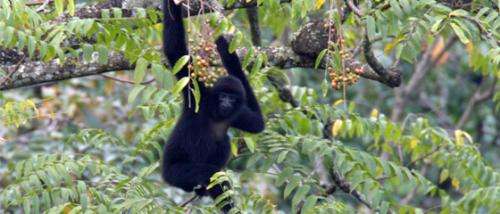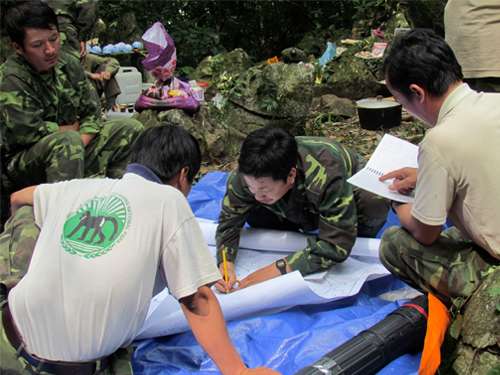A research team from Fauna & Flora International's (FFI) Vietnam primate programme has observed a record number of the Critically Endangered cao vit gibbon. During a two-week census survey, the team (led by biologists Nguyen The Cuong and Brian Crudge) recorded a total of 129 gibbons in the Cao Vit Gibbon Conservation Area in Cao Bang Province in northern Vietnam, the last known habitat for this species.
This is the highest number of cao vit gibbons recorded since the discovery of the population at Trung Khanh in 2002 and represents a 17% increase in the population since the previous census in 2007.
Cao vit gibbons once ranged across north-east Vietnam and south-east China but habitat loss and hunting have reduced their numbers to the extent that the species was long thought to be extinct. Today, the species is restricted to a single isolated population in the far north of Vietnam, on the border with China.
FFI biologists were the first to confirm the presence of 26 cao vit gibbons at the site in 2002. Since that time, FFI's team in Vietnam has been leading conservation efforts in the area, implementing a wide range of activities to reduce the threats to the gibbons and their habitat. These include improved forest protection, community outreach, livelihood development, environmental education, habitat restoration and ecological research.
Dr Ulrike Streicher, FFI Vietnam's Primate Programme Manager, said of the results: "They are fantastic. Everybody involved in activities to protect the cao vit gibbons should be complimented on their great efforts. Nothing reflects successful conservation activities better than increasing populations of the species you strive to protect."
Speaking about the census, Mr Nong Van Tao (Director of the Cao Vit Gibbon Conservation Area) said he was very pleased with the results and celebrated the joint achievement of the management board and FFI, and expressed his hope for long-term continuation of the cooperation.
FFI gibbon census team mapping the cao vit gibbon population. Credit: Brian Crudge/FFI.
Surveying by sight and sound
To carry out a complete population census of the gibbons, a group of 31 people led by FFI spent two weeks in the Cao Vit Gibbon Conservation Area. Observation posts were set up at 18 vantage points spread throughout the core zone of the conservation area.
Gibbon pairs strengthen bonds and mark their territory by singing loud and elaborate duets, usually at dawn. Calls can be heard up to a kilometre away and are distinct between males and females. During the census, two- or three-man teams spent eight hours (from 4 a.m. to midday each day) at the observation posts, where they listened for gibbon song and attempted to visually confirm the number of gibbons in each group.
"By triangulating between the observation posts we were able to confirm the locations of each gibbon group and calculate a minimum population size of 129 individuals," said Nguyen The Cuong, census coordinator.
"This is encouraging," said Dr Streicher, "as it shows that, with adequate protection and suitable habitat, the population of cao vit gibbons can bounce back. Whilst the overall conservation situation in Vietnam looks very gloomy, this shows that solid interventions on the ground can make a difference."
However, the survival of this species is far from secure. Cao vit gibbons remain one of the most endangered primates in the world; the species is classified as Critically Endangered on IUCN's Red List of Threatened Species, and is listed among the world's 25 most endangered primates.
"This success is one step, for the gibbons, on the long road to recovery. We must continue our efforts and build upon what we've already achieved," said Dr Streicher.
Provided by Fauna & Flora International























